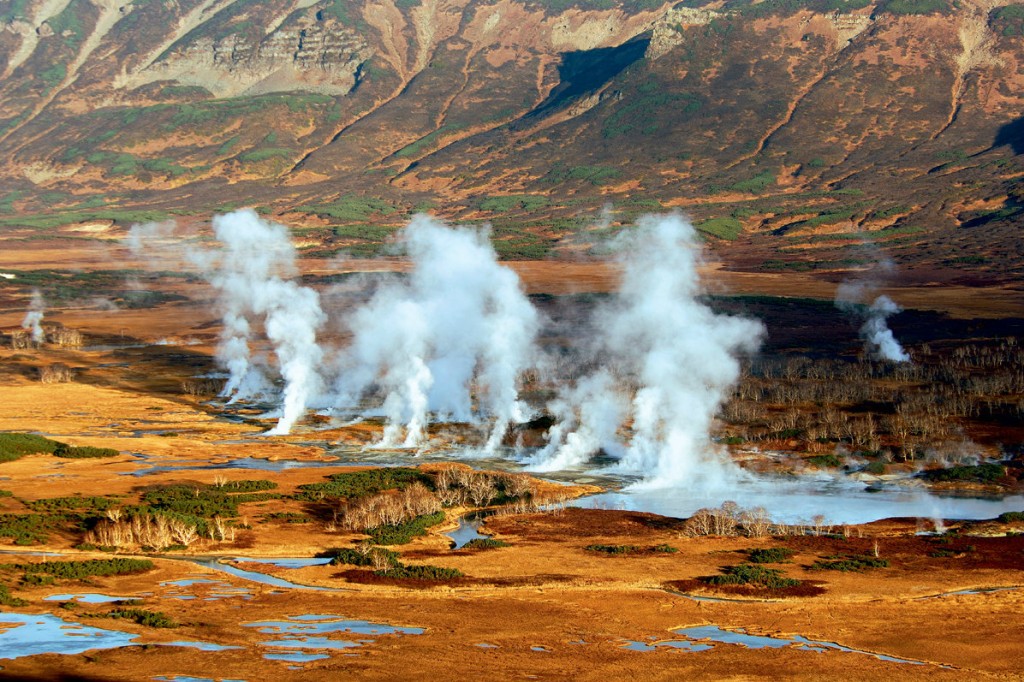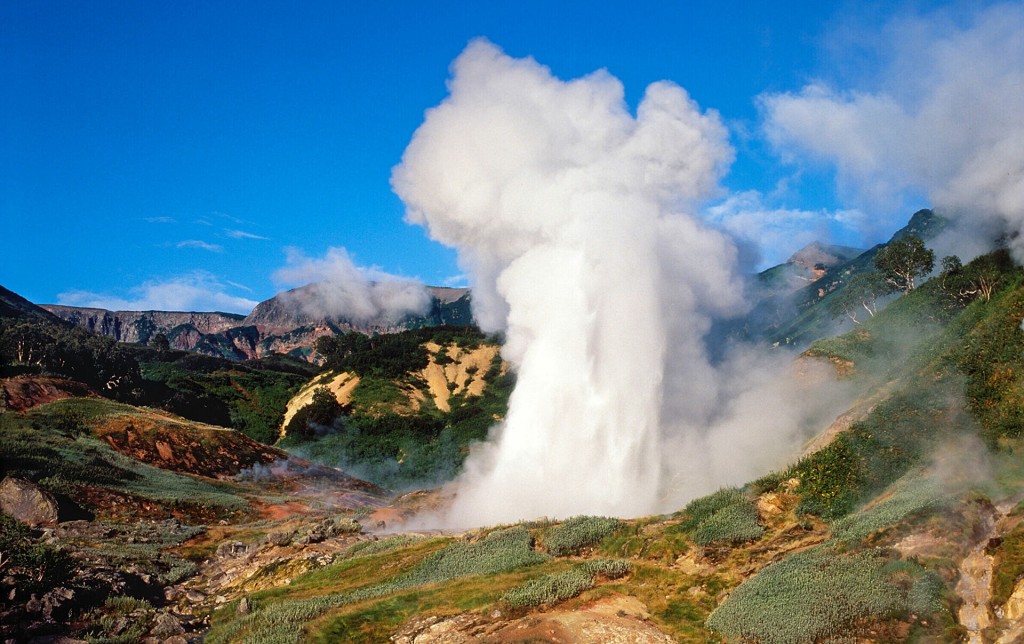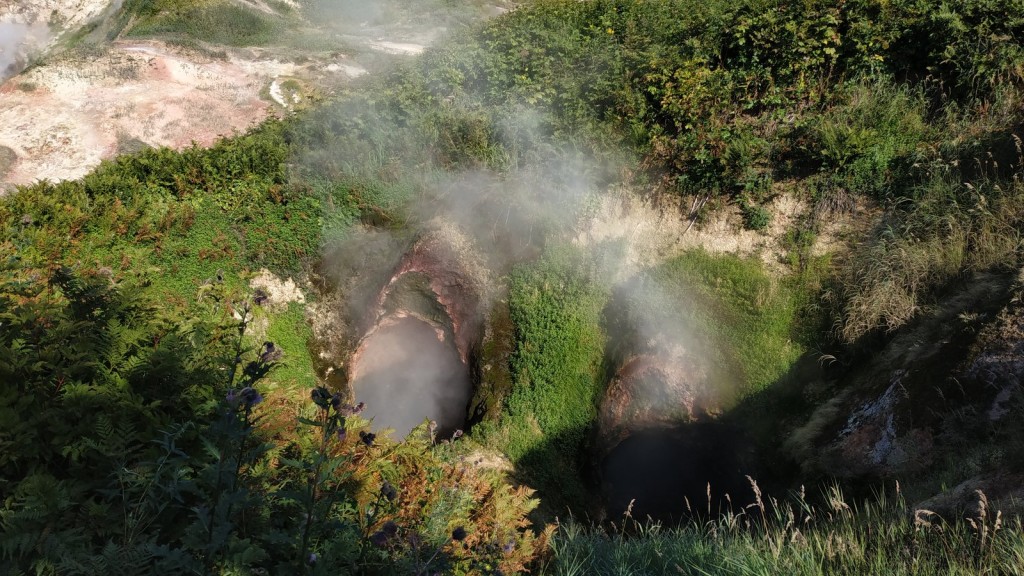March 16, 2023
Wonders of Russia: Valley of Geysers
Friends, we continue to introduce you to the natural wonders of Russia. Today we will go to Kamchatka, to the famous Valley of geysers. This unique natural area is part of Kronotsky State Biosphere Reserve, in the canyon through which the Geyser River flows. The total area of the valley is about 6 km2, and it is one of the largest geyser fields in the world. In total, there are about 40 geysers and hot springs, as well as mud boilers, volcanoes and steam jets escaping from the ground.

The geysers themselves are boiling springs, from time to time gushing with a steam-water mixture. Its temperature reaches 98 ° C. Some erupt every 10-15 minutes, some every few hours. The largest Giant geyser throws out 30 tons of hot water in a minute. The height of the water column is 35 m, and the steam rises to 300 m! And all this is accompanied by a deafening roar. No less interesting is another geyser with the ominous name the Gates of Hell or, as it is also called locally, the Dragon's Nostrils. It is constantly shrouded in steam holes in the ground, from which low-frequency noise and muffled sighs are heard. There are 26 named geysers in the valley. Among them are Zhemchuzhny, Bolshoy, Averyevsky, Grotto, Fortress, Impermanent, etc.

According to scientists, there is a high contrast of natural conditions and microclimate and abnormally high biodiversity in the valley. A unique ecosystem has developed around the hot springs, consisting of thermal bacteria, algae, lichens, etc. So, the oldest thermophilic blue-green algae, about 3 billion years old, live here in boiling springs. years, and on the slopes of the gorge grows Chinese curlew (Spiranthes sinensis) – a rare plant from the orchid family, which in Kamchatka can be found only here. But the largest inhabitants of these protected areas are, of course, bears, who like to feast on shiksha in local berry fields and bask on hot stones.

Interestingly, nothing was known about the valley until 1941, even to local residents. It was discovered by a researcher Of the Kronotsky Nature Reserve by Tatiana Ustinova and laboratory assistant Anisifor Krupenin. They saw a column of steam escaping from the ground and a jet of boiling water following it. So the first geyser of the valley, called the Firstborn, was discovered.
In the early 50s, this area was deprived of the status of a protected area, and a flood of tourists poured here, who irreversibly spoiled geyserites – unique silicon deposits surrounding the geyser outlet sites.
Since 1967, the valley has been restored to the status of a nature reserve. Tourism first became planned, and then it was stopped altogether, restored only in 1993. Now you can get here mainly by helicopter. Special trails are equipped for tourists, it is impossible to descend from them, and it is not safe: a harmless-looking layer of green grass may hide a dangerous swamp with a scalding viscous liquid.
Since the discoveries, the valley has changed its appearance several times thanks to the intervention of nature itself. Due to typhoon Elsa in 1981 and due to the landslide that caused a powerful mudflow in 2007, the valley was flooded, and many sources were blocked. But in 2013, a new mudflow not only restored the old sources, but also opened several new ones.
Now the Valley of Geysers is part of the UNESCO World Heritage site "Volcanoes of Kamchatka", and in 2008, according to the results of the popular vote, it was included in the list of 7 wonders of Russia.
Would you like to visit this place? Or maybe you've already been there?

The geysers themselves are boiling springs, from time to time gushing with a steam-water mixture. Its temperature reaches 98 ° C. Some erupt every 10-15 minutes, some every few hours. The largest Giant geyser throws out 30 tons of hot water in a minute. The height of the water column is 35 m, and the steam rises to 300 m! And all this is accompanied by a deafening roar. No less interesting is another geyser with the ominous name the Gates of Hell or, as it is also called locally, the Dragon's Nostrils. It is constantly shrouded in steam holes in the ground, from which low-frequency noise and muffled sighs are heard. There are 26 named geysers in the valley. Among them are Zhemchuzhny, Bolshoy, Averyevsky, Grotto, Fortress, Impermanent, etc.

According to scientists, there is a high contrast of natural conditions and microclimate and abnormally high biodiversity in the valley. A unique ecosystem has developed around the hot springs, consisting of thermal bacteria, algae, lichens, etc. So, the oldest thermophilic blue-green algae, about 3 billion years old, live here in boiling springs. years, and on the slopes of the gorge grows Chinese curlew (Spiranthes sinensis) – a rare plant from the orchid family, which in Kamchatka can be found only here. But the largest inhabitants of these protected areas are, of course, bears, who like to feast on shiksha in local berry fields and bask on hot stones.

Interestingly, nothing was known about the valley until 1941, even to local residents. It was discovered by a researcher Of the Kronotsky Nature Reserve by Tatiana Ustinova and laboratory assistant Anisifor Krupenin. They saw a column of steam escaping from the ground and a jet of boiling water following it. So the first geyser of the valley, called the Firstborn, was discovered.
In the early 50s, this area was deprived of the status of a protected area, and a flood of tourists poured here, who irreversibly spoiled geyserites – unique silicon deposits surrounding the geyser outlet sites.
Since 1967, the valley has been restored to the status of a nature reserve. Tourism first became planned, and then it was stopped altogether, restored only in 1993. Now you can get here mainly by helicopter. Special trails are equipped for tourists, it is impossible to descend from them, and it is not safe: a harmless-looking layer of green grass may hide a dangerous swamp with a scalding viscous liquid.
Since the discoveries, the valley has changed its appearance several times thanks to the intervention of nature itself. Due to typhoon Elsa in 1981 and due to the landslide that caused a powerful mudflow in 2007, the valley was flooded, and many sources were blocked. But in 2013, a new mudflow not only restored the old sources, but also opened several new ones.
Now the Valley of Geysers is part of the UNESCO World Heritage site "Volcanoes of Kamchatka", and in 2008, according to the results of the popular vote, it was included in the list of 7 wonders of Russia.
Would you like to visit this place? Or maybe you've already been there?
Read more
July 31, 2024
April 12, 2024
April 5, 2024